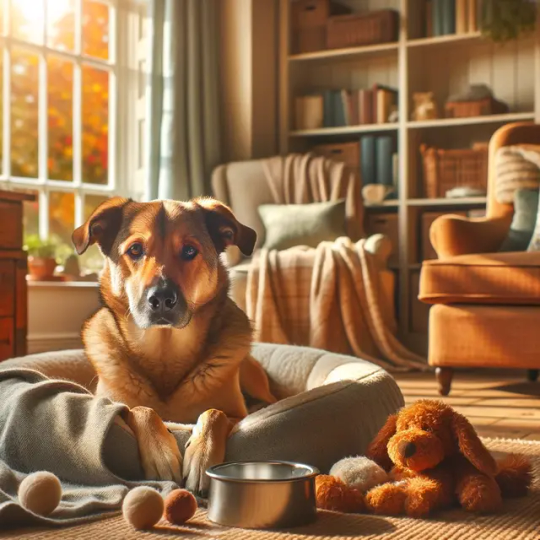#CreatingComfort
Explore tagged Tumblr posts
Text
Earning the Trust of Rescue Dogs: Creating Comfort in Their New Home

Rescue dogs come from a variety of backgrounds—some may have been abandoned, others surrendered, and many may have lived through trauma or neglect. No matter their story, when a rescue dog enters your home, it marks the beginning of a new chapter for them and for you. However, adjusting to this new life takes time, patience, and intentional care. Here’s how you can earn the trust of a rescue dog and help them feel comfortable in their new home.
1. Understanding the Importance of Patience
Every rescue dog is unique—while some might settle quickly, others may take weeks or even months to feel at ease. It’s important to remember that building trust takes time. Your new dog may be unsure of people, frightened by certain objects, or even confused by simple things like a doorbell.
Tip: Give your dog space to explore the home and come to you at their own pace. Avoid forcing affection, and instead let them initiate interactions.
2. Create a Safe Space
Your new rescue dog needs a quiet, comfortable space that is all theirs. This could be a cozy dog bed in a corner or a crate with the door left open. Dogs need a place where they can retreat and feel safe if they become overwhelmed.
Ideas for Creating a Safe Space:
Use a crate lined with soft blankets and keep it open for them to enter freely.
Choose a low-traffic area of the house for their bed, away from noise and activity.
Add familiar toys, treats, or scents (like a blanket from the shelter) to provide comfort.
3. Establish Routine and Consistency
Dogs thrive on routine, and establishing one will help your rescue dog feel more secure. Consistent feeding times, potty breaks, walks, and bedtime routines help your dog understand what to expect, reducing anxiety.
How to Create a Routine:
Feed your dog at the same times every day.
Walk and play sessions should follow a predictable schedule.
Use the same commands and cues for training to avoid confusion.
4. Use Positive Reinforcement
Training is essential for rescue dogs, but the key to success is positive reinforcement. This means rewarding good behavior with treats, toys, or praise, rather than punishing unwanted behavior.
Training Tips:
Reward calm behaviors like sitting quietly or coming when called.
Use a gentle tone to communicate with your dog and encourage them.
Be patient with accidents—use them as teaching moments rather than reasons for punishment.
5. Build Trust with Calm, Gentle Interactions
Many rescue dogs may be wary of people, especially if they’ve experienced neglect or abuse. Building trust requires gentle, calm interactions that show the dog they are safe. Avoid sudden movements or loud noises that might startle them.
How to Build Trust:
Sit on the floor at their level and let them approach you.
Offer treats from your hand to create positive associations.
Speak softly and avoid prolonged eye contact, which some dogs may find intimidating.
6. Give Them Time to Decompress
Rescue dogs often experience stress from their previous environment. When they come to a new home, they need time to decompress. During this period, it’s important to avoid overwhelming them with too much attention, visitors, or new experiences.
Decompression Guidelines:
Limit the number of people or animals they meet in the first few weeks.
Keep walks short and in calm, familiar areas until they build confidence.
Allow them to explore the house and yard at their own pace.
7. Encourage Bonding Through Activities
Bonding with your rescue dog will strengthen your relationship and help them feel more secure. Activities like walks, games, or even grooming sessions can foster trust and connection.
Bonding Activities:
Go on daily walks to explore new areas together.
Play simple games like fetch or hide-and-seek with toys.
If they are comfortable, groom them gently to build positive touch associations.
8. Pay Attention to Body Language
Rescue dogs may not be able to tell you how they feel, but their body language speaks volumes. Understanding what your dog’s signals mean can help you respond appropriately and avoid stress triggers.
Common Signs to Watch For:
Tail tucked, ears flattened: Fear or discomfort.
Yawning or lip licking: Stress or anxiety.
Relaxed body, wagging tail: Comfort and happiness.
9. Introduce New People and Pets Slowly
If you have other pets or expect visitors, it’s important to introduce them to your new rescue dog gradually. A slow introduction prevents overwhelm and helps your dog adjust at their own pace.
Introduction Tips:
Start with leashed introductions to other pets.
Let visitors offer treats and allow the dog to come to them.
Supervise interactions and be ready to step in if the dog seems stressed.
10. Celebrate Small Wins
Progress with a rescue dog can be slow, but every small victory counts. Celebrate milestones like the first time your dog wags their tail, eats comfortably, or comes to you for affection. Recognizing these moments builds confidence in your dog and strengthens your bond.
Final Thoughts
Bringing a rescue dog into your home is a beautiful, life-changing experience for both you and the dog. Though the process may come with challenges, the rewards of earning their trust and seeing them thrive are priceless. With patience, love, and consistent care, your rescue dog will come to understand that they are finally safe and truly home.
By following these steps, you’ll not only make your rescue dog feel comfortable but also build a lasting, trusting relationship that will bring joy to both of your lives for years to come.
If you’ve recently welcomed a rescue dog, what steps have helped your new friend settle in? We’d love to hear your stories in the comments!
#RescueDog#AdoptDontShop#DogRescue#RescueDogLove#SaveALifeAdopt#ForeverHome#ShelterDog#BuildingTrust#NewHomeNewHope#TrustTheProcess#PatienceAndLove#FromFearToForever#HealingWithLove#RescueDogJourney#CreatingComfort#SanctuaryLife#SafeSpaceForDogs#DogTrainingTips#HelpingDogsHeal#HomeSweetHome#InfiniteHeartsDogSanctuary#FosterToAdopt#AnimalAdvocate#EndPetHomelessness#AdoptNotShop
3 notes
·
View notes
Text
I cant wait til my new furniture comes in and I have a bedroom you've never been in..
0 notes